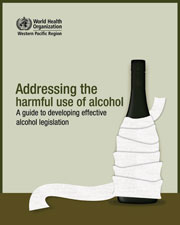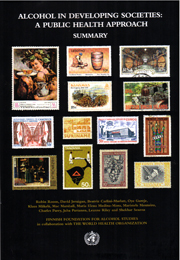
|
Alcohol/drugs and hiv/aids In the menu to the left you will find reports to download and links to web sites with more information, both general information on hiv/aids and more specific on the role of alcohol and drugs. Below we present a brief introduction to possible connections between alcohol and HIV/AIDS. This is a summary of a more comprehensive document that is also available from the menu to the left. This web page will step by step be updated and completed with more material. |
||
|
A gradually stronger evidence base There is a huge amount of research and documentation available on most aspects of the HIV/AIDS pandemic, including documentation on injecting drug use as a risk factor to contract HIV. This connection has been experienced and documented from the early phases of the AIDS pandemic. Alcohol use and drunken behaviour is not at all that well documented as a risk factor to contract HIV or to develop AIDS. This situation is now gradually changing. An increasing amount of research is being conducted on HIV/AIDS and alcohol, and the connection between the two is coming gradually clearer also from a scientific perspective. In real life the connection has long been experienced by very many, both ordinary people, HIV experts and development workers, but without resulting in too many systematic studies of the phenomenon. This document is a summary of a more comprehensive text which explores existing knowledge on possible connections between alcohol consumption and HIV/AIDS. A web version is available here. Based on the reviewed material we have identified three areas of interaction between alcohol/drunken behaviour and HIV/AIDS: 1. Alcohol contributing to the spread of HIV/AIDS 2. Alcohol boosting the development of the disease 3. Alcohol reducing the effects of medical treatment We are now working on a material that covers a fourth connection, which belongs to the field of prevention strategies: 4. Methodological parallels between prevention of HIV/AIDS and alcohol Material on this will be presented at the ADD web site in due course. 1. Alcohol contributing to the spread of HIV A. Social, cultural and psychological links A considerable number of social, cultural and psychological aspects of alcohol use and drunken behaviour – and also combinations of these aspects - may lead to increased risk to contract HIV. The WHO report, “Alcohol Use and Sexual Risk Behaviour: A Cross-Cultural Study in Eight Countries”[1] points out some key patterns of interaction between alcohol use and sexual behaviour, based on review of available research literature and empirical studies in eight countries; Kenya, South Africa, Zambia, Mexico, Belarus, Romania, The Russian Federation and India. Analysis of the data in the WHO report showed that not only did alcohol use and sexual behaviour separately pose risks for STI/HIV infection, but also collectively. In a number of ways alcohol use and sexual behaviour and beliefs actively “supported” one another, with alcohol use and beliefs acting as both precursors and outcomes of sexual behaviour. The particular manner in which alcohol use and sexual behaviour interacted, however, varied to some extent across the eight countries. Links that are explained in more detail in the full version of this document: · Alcohol use as part of the construction of maleness · Alcohol as a facilitator for sexual encounters and intercourse · Alcohol-serving places as contact places for sexual encounters · Denial and neglect of risk as a way of coping with life · Alcohol in special risk groups · Groups vulnerable to alcohol use, sexual risk behaviour and HIV · Privileges attached to alcohol and drunken behaviour · Alcohol is associated with violent behaviour, including sexual violence and sexual abuse · Sensation seeking · Alcohol in combination with injecting drug use B. Biomedical links A growing body of evidence suggests a direct biomedical link between alcohol consumption and HIV infection and disease. It is well known, independent from the HIV/AIDS issue, that the use of alcohol can impair a person’s immune system and that this effect increases with the alcohol consumption level. Every episode of alcohol intoxication can suppress multiple elements of the immune function in the human body. This can contribute to an increased incidence and severity of infections such as pneumonia, tuberculosis and hepatitis C. C. Co-variation between alcohol consumption and HIV infection There is substantial documentation from a number of countries and cultures that there is a co-variation in some population groups between high alcohol consumption or hazardous drinking patterns and the prevalence of HIV/AIDS. In their web page on this topic, the NIAAA in the US conclude that people with alcohol use disorders are more likely than the general population to contract HIV. Similarly, people with HIV are more likely to abuse alcohol at some time during their lives. 2. Alcohol boosting the development of the disease Alcohol abuse can impair a person's immune system, leading to infections like pneumonia and also an increased susceptibility to HIV infection. However, the adverse consequences of heavy alcohol consumption on the HIV disease progression are poorly understood. Researchers have failed in documenting the direct association between alcohol use and HIV disease progression. With the new study of rhesus monkeys and SIV mentioned in paragraph 1b above, this may be changing. The monkey study carried out by Bagby et al, indicates not only that drinking alcohol may increase the susceptibility to contract SIV/HIV, but also that chronic binge drinking can accelerate the progression of end-stage simian immunodeficiency virus (SIV) among rhesus macaques, likely mimicking what happens to humans infected with HIV. In persons already infected, the combination of heavy drinking and HIV has been associated with increased medical and psychiatric complications and also delays in seeking treatment. Research from several countries and different cultures has established that HIV-infected people are more likely to consume alcohol than the general population. This fact makes it even more crucial to study the impact of alcohol on the development of the disease, once you are HIV infected. 3. Alcohol reducing the effects of medical treatment A. Alcohol and ARV therapy/nutrition HIV is a virus that can make copies of itself in a cell. These new copies can then infect new, healthy cells in the body. If the HIV is not stopped from replicating itself, the virus will quickly spread to cells all over the body. The drugs used in antiretroviral treatment slow down the replication of HIV in the body The ARV therapy is effective only if the patients adhere strictly to the regimen. Medication must be taken every day, for the rest of the patient’s life, and the correct dose must be taken. Normally patients take two or three drugs in a daily dose, in order to avoid developing resistance to one single drug. Nutrition is another essential part of any HIV care package. An adequate quantity and quality of food contributes to strengthening the immune system. Nutrition is not enough in itself to keep infected persons healthy, but it may help prolong the period of time between HIV infection and the development of AIDS and/or the onset of opportunistic infections. It is easy to understand that alcohol consumption may influence a person’s capacity to follow up a strict medication regimen:
There is now some documentation available on the impact of alcohol on adherence to ART medication. At a conference in Toronto, Canada in 2006 the results of a computer simulation were presented. In this study alcohol consumption was shown to have a significant impact on the survival of HIV infected persons, ranging from one year and up to 6,4 years. Hazardous drinking decreased overall survival by more than 3 years, if the frequency of consumption was once a week or higher, and by 6,4 years with daily consumption. Moderate drinking decreased survival by more than one year if consumption occurred once a week or more often, and by 3,3 years with daily consumption. This connection may be explained by poor adherence to the ARV treatment or by the fact that drinking impairs the immune system, or a combination of the two. This is, however, an area where much more long time studies are needed. B. Alcohol and the immune system The purpose of ARV treatment can be said to be to support the body’s immune system in fighting the spread of HIV to non-infected cells and to avoid the development of opportunistic infections. When we know that drinking alcohol impairs the immune system, like HIV also does, it is likely that drinking will reduce the effect of ARV treatment also in a biomedical way, not only through reduced follow-up of a ARV medication regimen. C. Alcohol and the liver Alcohol has been proven to interfere with liver function, affecting its ability to metabolize certain antiretrovirals (ARVs), particularly protease inhibitors, thus reducing their therapeutic efficacy and increasing the likelihood of drug resistance. The need for more documentation As shown in the paragraphs above, there appears to be quite a number of links between alcohol consumption and the HIV/AIDS issue. Recognizing this fact, there is an urgent need to develop more documentation on the various links:
[1] WHO report “Alcohol Use and Sexual Risk Behaviour: A Cross-Cultural Study in Eight Countries”, ISBN 92 4 156289 7, Geneva 2005. 2007-04-23
|
||
![]()
![]()
![]()
Developed with CustomPublish CMS by Nettinfo AS




